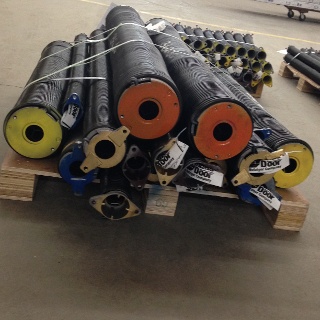Most people push the button to open their garage doors with little understanding of how the movement and function of these massive doors really occurs. Every commercial garage door has a motor that helps to power the open and close motion, but the real power comes from something else entirely. Torsion springs do more of the work than you might imagine, and are very important to the overall performance of a commercial garage door.
COMMERCIAL TORSION SPRING EXPLAINED
Torsion springs are typically mounted above the garage door opening. While commercial garage doors do have a motor, most motors have insufficient power levels to actually lift the door on their own. When the door is in motion, cables attached to the underside of the door cause the torsion springs to wind up, which creates stored energy as the door closes.
As the door opens, those same springs unwind and the stored energy contained within help power the door. Over an extended period of time, this constant winding and unwinding of the commercial torsion spring weakens the mechanism and makes the door heavier and heavier to life. Eventually torsion springs break and the door becomes stationary in either the open or closed position.
TYPES OF COMMERCIAL TORSION SPRINGS
If you're in the market for a new commercial torsion spring, you first need to clarify which type of mechanism is used on your current commercial garage door. Once you have that information, you can compare the available torsion spring options available for replacement. There are three common types of springs available, each of which provides its own benefits. These include:
- Black Coated Wire: Oil-tempered torsion springs have long been the standard, but with internal aesthetics just as important as garage door operation for many commercial and industrial companies, black-coated wire is increasingly popular. The springs are thermal-dipped in coating and provide a simple counter-balance mechanism to open garage doors that is aesthetically pleasing at the same time.
- Galvanized Wire: A galvanized commercial torsion spring helps reduce the formation of surface rust on the spring, while providing a lustrous interior finish at the same time. Not only does this type provide a clean, shiny appearance, but it is ideal for operation in environments with a lot of moisture.
- Square Wire: A square wire torsion spring is an excellent option for applications where you need more life cycles (to open a heavy door) in a little space. Square wire torsion springs offer maximum power in a small space.
HOW TO MAINTAIN TORSION SPRINGS
Because a commercial torsion spring stores a lot of tension, it is not something to be messed with if you aren't familiar with the mechanism or comfortable maintaining it. You can perform spot assessments of your torsion spring by disconnecting the garage door opener from the opening mechanism and the power. Climb a ladder and look at the torsion shaft. Locate the torsion shaft, and inspect the brackets at either end. Have someone else lift the garage door a few inches up and down while you keep a close eye on the torsion shaft bar, ensuring that the shaft is rotating smoothly.
If you notice the operation is not smooth, apply a lubricant to the entire length of the torsion spring except the last inch before the winding bracket. If you notice any other issues, it is best to contact a professional garage door service company and request a service visit to inspect the performance and condition of your commercial torsion spring.
